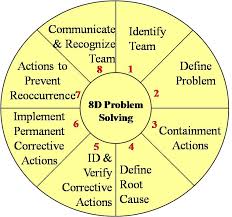Corrective Actions are a necessary evil. Anyone with any semblance of a quality system has to process them. And there are many theories and recommendations for the best way to process them. Following the 8D process is one of them, and it’s fairly popular these days.
The American Society for Quality (ASQ) defines the process as follows:
“The eight disciplines (8D) model is a problem solving approach typically employed by quality engineers or other professionals and commonly used by the automotive industry. Its purpose is to identify, correct, and eliminate recurring problems, and it is useful in product and process improvement.
The approach establishes a permanent corrective action based on statistical analysis of the problem and focuses on the origin of the problem by determining its root causes. Although it originally comprised eight stages, or disciplines, it was later augmented by an initial planning stage.”
So, the 8D process, or rather Eight Disciplines process involves, well, 9 disciplines. They are D0, 1, 2, 3, 4 5, 6, 7 and then 8. Yeah. Not very helpful, sorry. The 9 disciplines of the Eight Discipline problem solving process are, according to ASQ, D0: Plan, D1: Define/use a team, D2: Define/describe the problem, D3: Develop interim containment, D4: Determine, identify and verify root cause, D5: Choose and verify corrective action, D6: Implement and validate corrective action, D7: Take preventive measures and D8: Congratulate your team.
D0, 1, 2, 3, 4 5, 6, 7 and then 8. Yeah. Not very helpful, sorry. The 9 disciplines of the Eight Discipline problem solving process are, according to ASQ, D0: Plan, D1: Define/use a team, D2: Define/describe the problem, D3: Develop interim containment, D4: Determine, identify and verify root cause, D5: Choose and verify corrective action, D6: Implement and validate corrective action, D7: Take preventive measures and D8: Congratulate your team.
The following link is to an ASQ article that provides a good summary of the disciplines used in the process.
http://asq.org/learn-about-quality/eight-disciplines-8d/
Truth be told, I like the 8D process. When implemented properly, the process will effectively eliminate process as well as product problems. So what’s overrated about it?
What is overrated about the process is what is overrated about many processes, forms and procedures. They become about the process of solving the problem rather than solving the problem. This can be particularly true when using a form to document the 8D. The problem solving process no longer is about solving the problem, but about completing the form.
This is where D0 and D1 come in. Planning and Defining the team. For D1, ASQ says “Establish a team of people with product/process knowledge.” I would add to that, establish a team of people with product/process knowledge who are interested in solving the problem. A team of people with product knowledge is not enough. The members of the team must care about solving the problem. Otherwise it becomes a “check the box, complete the form, get it over with” process rather than a problem solving process.
So, part of the plan (D0) for the 8D is to determine the people with knowledge of the process or product that are going to be interested in solving the problem (D1).
Another critical point in the process is at D2, the defining of the problem. Oftentimes, the definition of the problem is too broad, or too specific, to be really useful. This is why it’s critical to define your team well. The team needs to define the problem in a clear and focused manner. As ASQ puts it, the definition needs to be in “quantifiable terms.” I would add that the members of the team must be in agreement with the definition of the problem and how it is quantified, at least at the end. Disagreement during problem definition is a good thing, but disagreement at the end, when you are finalizing what it is you are trying to solve, is bad. So bad, in fact, that you probably shouldn’t be taking any additional steps down the 8D process until agreement is reached on what the problem is and how it can be measured.
Consensus with respect to the problem definition (D2) is critical in formulating a good Root Cause (D4). A good Root Cause is critical in defining effective preventive measures (D7). Having a quantifiable problem definition (D2) is important for establishing criteria for verification. Verification is a huge part of the 8D process.
There are verification steps at each juncture in the process. This is very important, particularly when the process of solving the problem takes an extended period of time. It would be bad to be days or weeks into a problem solving process before finding out that actions taken on day 2 to address an issue were found out not to be effective on day 6. That would be 4 days of wasted effort.
In all, the 8D process is actually very good and can be a wonderful tool to aid in solving an array of process or product problems.
How, then, can the process be implemented and utilized without having it become rote; a fill in the box process?
Be sure to give proper consideration to planning (D0) and defining the team (D1). The members of the team must be knowledgeable about the process or product, and must desire to see the problem solved.
Achieve consensus on the problem definition (D2) quantifiably.
Finally, consider not using an 8D form to document the 8D process. Document the output of  the 8D process by its outputs that specifically address the problem. The outputs are a problem definition (D2), containment actions (D3), root cause (D4), permanent corrections (D5), corrective actions (D6) and preventive measures (D7). D0 and D1 are important to the process, but they don’t need to be on a form. Congratulating your team (D8) is important, but it doesn’t need to be documented on a form. It simply needs to be done. Don’t even call the form an 8D form. Call it a Corrective Action; call it a Problem Solving Form; call it Bob; just don’t call it an 8D Form.
the 8D process by its outputs that specifically address the problem. The outputs are a problem definition (D2), containment actions (D3), root cause (D4), permanent corrections (D5), corrective actions (D6) and preventive measures (D7). D0 and D1 are important to the process, but they don’t need to be on a form. Congratulating your team (D8) is important, but it doesn’t need to be documented on a form. It simply needs to be done. Don’t even call the form an 8D form. Call it a Corrective Action; call it a Problem Solving Form; call it Bob; just don’t call it an 8D Form.
There are other problem solving processes that can be followed as well. And the critical parts of the 8D process are, in all likelihood, the same critical parts for any problem solving process. Use a team of people who desire to see the problem solved, have the knowledge to do it, and can achieve consensus on a quantifiable problem definition. Spending time on these areas will greatly increase the chance of solving whatever process or product problem you face.
About the Author
Tim Wunder is Director of Quality Assurance for RESCO Electronics, a manufacturer of  electronic assemblies and a value added reseller of auto ID equipment. Tim is a seasoned quality management professional with over 36 years of experience in the electronics industry, the past 12 in quality assurance. During his career Tim has implemented ISO 9001 compliant quality systems at four different RESCO facilities since 2004.
electronic assemblies and a value added reseller of auto ID equipment. Tim is a seasoned quality management professional with over 36 years of experience in the electronics industry, the past 12 in quality assurance. During his career Tim has implemented ISO 9001 compliant quality systems at four different RESCO facilities since 2004.
Tim is a graduate of Towson State University with a Bachelor of Science in both Mathematics and Computer Science. He is married with two sons and a daughter-in-law and currently resides in Maryland.


